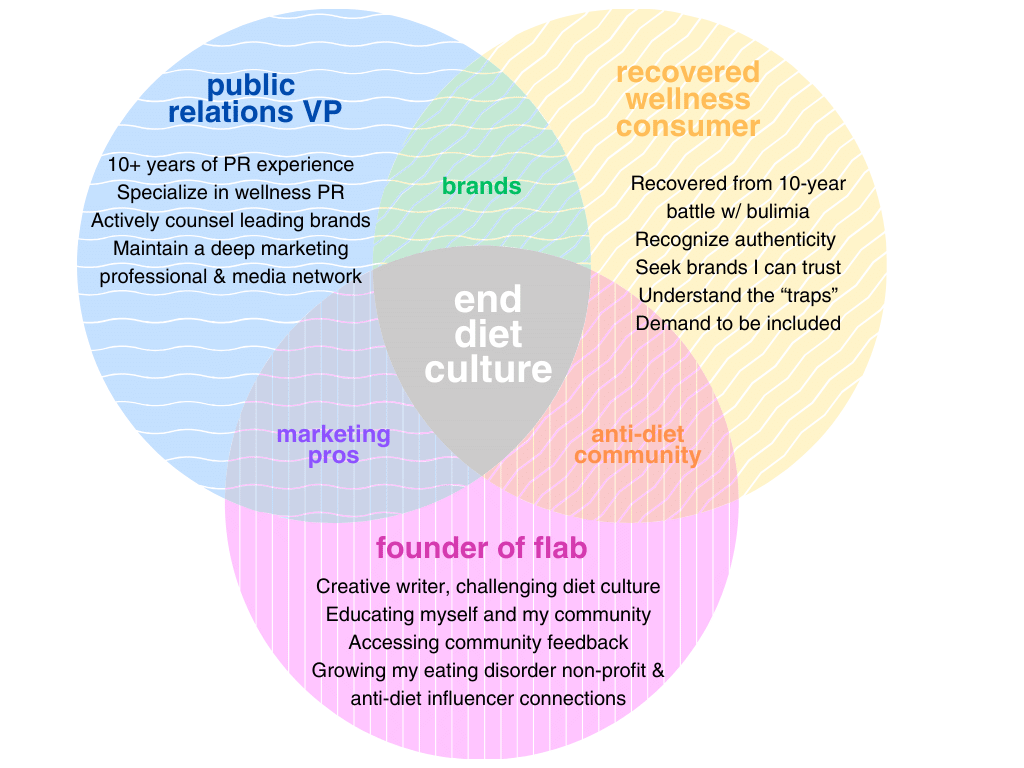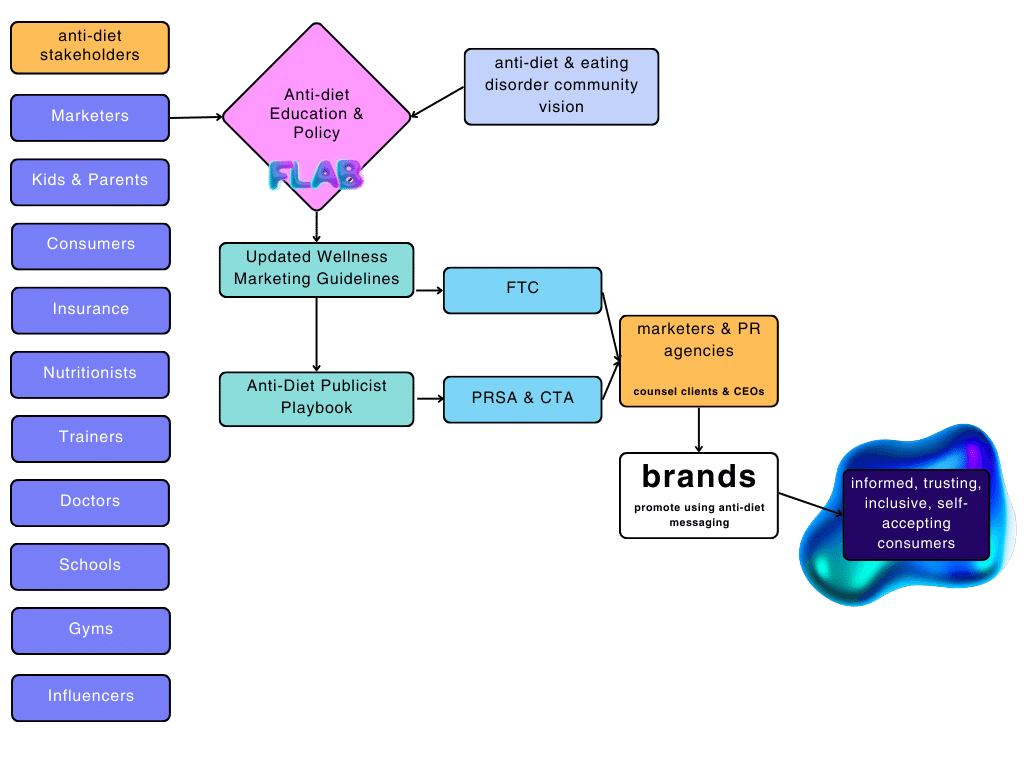Hey friends,
I spent this weekend in the Windy City with the grown women of my family. We shared stories about our kids and our hopes for our careers. We built up our collective wisdom, like the proper shampoo for our shared flaky scalp problem — no it’s not “hard water” or some obscure food allergy, it’s genetic psoriasis. I was happy to save my cousin from spending money on products that won’t work, and save her hours of researching unhelpful “natural” solutions, that ofc involved some form of dieting.
But, as I tried to share what I was up to at work as a Vice President of a national public relations firm, and over here at flab, I fumbled through an explanation. I tried turning to the therapists in the family and even tried stirring up some clarity from a midnight Tarot card session, but I still couldn’t quite nail it down. Then, my super-smart aunt suggested a simple fix — make some charts!
Here’s what I’m doing:
As Maria von Trapp would say… let’s start at the very beginning, a very good place to start! From age 15-25, I battled bulimia. I don’t talk a TON about the details, partly because those ten years of my life are mostly a blur, and partly because the type of therapy I used to kick my eating disorder to the curb was DBT, an approach that focuses less on the why, and more on the how to stop target behaviors. It’s only now that I have my two daughters and a clear mind from cutting out alcohol that I’ve started to be able to dig into the why behind my eating disorder. The gist is that my eating disorder was all-consuming. I thought about my meals, weight, body, and exercise 99% of every waking moment. I lost touch with all my passions, I faked nearly every social interaction (I wasn’t listening to you, I was thinking about my eating disorder) and I purged literally all over town. I still today, over ten years later, feel a twinge of pain when I walk into a restaurant restroom I thought I’d never been to, but then remember how rampant my eating disorder was. DBT, learning to sit through discomfort, honesty with my support network (family!), rest, and filling my life up with meaning helped me get unstuck.
Cut to today, I’m a VP at a really cool PR agency, where I counsel leading brands in health, fitness, and wellness on how to stand out to consumers and get the press to write about them. I’m pretty good at it, and I was even named by the EIC of Entrepreneur Magazine as one of the best publicists in the game. I make stories like this, this, and this happen. I shine up a brand’s story and get them introduced to media & influencers who will (hopefully) be persuaded to tell their audience about my client’s world-changing idea. I do a lot of this work from my home office, staring at images of bodies that depict “wellness” all day while stress-eating snacks that I later regret.
During my morning news scrolls, I see a lot of scienceploitation, and flat-out unawareness that a brand’s rigid “clean eating” talk feels outdated, and reads like an eating disorder (Orthorexia, to be exact) by another name. Note, I generally think most brands are not trying to be malicious, rather, they just need a lesson in how the times are a-changin', and we can do more good by bringing people along rather than taking them down. I share the latest reports from experts like
who’s forecasted that the hyper-productive wellness era is on its way out. I help brands adapt to the shifting landscape, like how Gen Z is seeking out brands that simply make wellness fun and approachable, vs. something that’s only reserved for women with a wide-open schedule and a Centurion card.At night, I write the flab newsletter on
. It’s primarily a creative outlet because writing is my therapy (but also therapy is my therapy). I share little moments from my life to connect with people on my wavelength — former ClassPass Unlimited junkies that have “reset their gut” an obscene amount of times; people who are over detoxes, but who are unsure of how (or are too afraid) to officially break up with diet culture.Moments like how today, at my daughter’s survival swim class, I made up a whole story about how effortless the tanned, toned, and *thin* mom standing next to me was. She was dressed in hunter-green (she’s outdoorsy!) biker shorts, a white tank, oval sunglasses, and trendy branded ankle socks that alone cost more than my entire outfit, which was built around the only clean pair of Target leggings I could find. I imagined that she probably didn’t exercise (just hikes!) and genuinely enjoyed salads for dinner. I was jealous and mad at myself for eating pizza last night.
And then as soon as class ended, she took out a portable blow dryer and styled her six-year-old son’s hair to be as equally effortless as hers. I didn’t even know those existed. Maybe there was a good reason (flaky scalp?!) for it, but it left me thinking that her embodiment of the “healthy ideal” was probably hard-earned, and not as effortless as I imagined her to be. This is not a judgment on her, I share this insight as an example of the unrealistic comparison games my mind plays in a matter of minutes, without knowing anything about someone. I’m catching and extracting myself from diet culture’s web In real time.
Beyond sharing these ”aha moments”, there’s something more brewing at flab. A quiet little “idea factory” is taking shape. Something’s percolating inside me to do something to end diet culture. There are already incredible activists in this space focusing on shifting diet culture’s impact on key stakeholders like kids, schools, physicians, policy, general consumers, journalists, and people living in larger bodies.
So, I’m zeroing in on the thing I know best: the marketers. I am educating and up-leveling the thinking of marketers, and in turn, brands, and helping them be on the right side of wellness.
Here’s how I’m contributing to the end diet culture, by focusing on my little slice of the pie:
And, it seems to be working! Organizations are taking meetings with me to review my suggestions and explore how we can work together. Anti-diet nutritionists are interested in collaborating with me on my guidelines. Brands are taking my advice!
Here's a snapshot of my revised anti-diet marketing guidelines, which I'll be improving with insights from the community over the coming weeks.
Why These Guidelines Matter
Reduce Stigma: brands will contribute to a more compassionate and understanding approach to health, which can encourage individuals to seek the support and care they need without fear of judgment.
Increase Consumer Trust: communicate responsibly about health conditions, build greater trust among, and become caring and credible sources of information.
Support Public Health: accurate, empathetic communication about wellness that promotes understanding and supportive approaches.
Key Concepts
Healthy Ideal: Often represented as a slim, toned figure, this ideal overlooks the wide range of natural body types and the multifaceted nature of health.
Obesity Myth: Challenges the view that obesity is inherently negative or solely within an individual's control, recognizing the complex interplay of genetic, environmental, and social factors.
Eating Disorder and Dieting Statistics: Studies show that dieting behaviors can start as early as kindergarten, with significant impacts on long-term health and well-being. Public health initiatives increasingly aim to shift focus from diets to diverse, balanced lifestyles.
Health at Every Size (HAES): A movement that promotes acceptance of diverse body shapes and sizes and emphasizes health outcomes rather than weight control. It advocates for compassionate healthcare that eliminates weight discrimination and focuses on individual well-being rather than conforming to societal body standards. HAES encourages flexible, individualized eating based on hunger and nutritional needs, and supports enjoyable physical activities tailored to various sizes and abilities. This approach challenges the conventional view that weight is inherently indicative of health, advocating for a more holistic understanding of well-being.
Proposed Updated Wellness Marketing Guidelines:
Promote body diversity & inclusion: feature a diverse range of body types, ages, races, genders, and abilities in marketing materials to reflect the broad spectrum of consumers. Emphasize that health and wellness vary widely among individuals and aren't defined by appearance. Consider if a campaign can be communicated with no images of bodies.
Avoid weight-centric language: Shift the narrative from weight loss to overall well-being. Avoid terms like "slimming" or "weight loss," focusing instead on benefits such as stress reduction, enhanced energy, and improved mood. Create a strategy for how your brand will use terms like "obesity", balancing clinical accuracy with the consideration of social and psychological impacts.
Highlight functional benefits: Focus on the functional and holistic health benefits of products. Educate consumers on making informed choices based on health and functionality rather than physical appearance.
Use empowering language: Use a tone that is uplifting and non-judgmental, reinforcing that personal value is not linked to body size. Promote self-care and health maintenance as acts of self-respect.
Educate on Health at Every Size (HAES): Incorporate HAES principles into marketing, challenging the conventional narrative that health is directly linked to weight loss. Show that health outcomes can be achieved at any size, and educate on the diversity of healthy lifestyles.
Transparency and Honesty: Ensure that marketing claims are honest and transparent, avoiding exaggerations that prey on body insecurities. Maintain credibility by accurately representing the benefits and limitations of products.
Regular Review and Update of Content: Keep marketing materials current with the latest scientific research and societal views on health and wellness. Adapt marketing practices to stay relevant and inclusive.
Broaden the Definition of Health: Encourage representations of health that extend beyond traditional exercise imagery, such as engaging in community activities, spending time outdoors, or enjoying moments with family, to show a more comprehensive view of health.
Avoid Scienceploitation: Base health claims on solid, peer-reviewed scientific evidence. Provide consumers with clear, understandable explanations of how products work, avoiding scientific jargon and unsubstantiated claims Be clear and upfront about a study’s limits, and if more research needs to be done. Advocate to make that research happen.
Change takes time, but steady is my course. Especially with my shiny new charts to guide me.
✌️🤟
Jen S.
P.S. What do you think of the new look?







I love this Jen! You are presenting a clear mission, vision, and action plan all while being totally authentic. Watch out world!